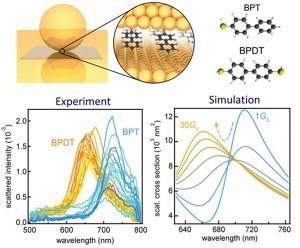NANO-OPTICS OF MOLECULAR-SHUNTED PLASMONIC NANOJUNCTIONS
The interplay of photons and electrons in a molecule is at the base of modern molecular optoelectronics, however to access the transport properties of molecules at very high AC frequencies is not possible with the current capabilities of electronics.

A joint recent study between researchers from Cambridge and Donostia analyses the optical response of a plasmonic metallic cavity shunted by molecular linkers as a monitor that provides valuable information about this ultrafast transport regime. Furthermore, the optical methodology introduced in this work can determine the number of molecules involved in the transport through a cavity, as well as their unitary conductance. The results obtaining by this collaborative effort thus impacts the field of molecular devices for optoelectronics.
Metallic junctions provide a fantastic platform to test molecular transport properties. When a bias between two metallic electrodes is applied the current through the junction is mainly determined by the distance between the two metallic interfaces, as well as by the intrinsic transport properties of the material within the junction. In a collaboration with the Nanophotonics Centre in Cambridge (U.K.), researchers from the Center for Materials Physics in Donostia-San Sebastián have explored the optical fingerprints of conductivity in molecular-shunted plasmonic junctions.
In this work, the optical response of a cavity plasmon was monitored as a function of the molecular conductance across the cavity formed by a nanoparticle deposited on a metallic surface (see schematics of the system on top of the figure). To progressively change the conductance at the cavity, two different species of molecular linkers were used: (i) a conductive biphenyl-4-4′-dithiol (BPDT) molecule with the thiols linked to both metallic interfaces forming the cavity, and (ii) a biphenyl-4-thiol (BPT) molecule where one of the thiol connections of the BPDT is removed, preventing conduction through it. The chemical structure of both molecules can be observed on the top of the figure, on the right hand side. As the ratio of the conducting molecules within the cavity is progressively modified with respect to the nonconducting ones, a screening of the cavity plasmon is produced, that progressively modifies the capacitance of the bonding plasmon formed at the cavity, and thus modifying its resonance wavelength. This behavior had been predicted by researchers at the CFM, and has been now corroborated experimentally by the researchers in Cambridge led by Prof. J. J. Baumberg. The results show an experimental blue-shift of the screened plasmon of about 60 nm, as observed in the figure attached (bottom, left), when all the nonconductive molecules are substituted by conducting ones. According to the numerical calculations developed at the CFM in San Sebastian, a conductance of 30 Goacross the cavity (with Go the quantum of conductance) is necessary to produce the observed blue-shift. By applying a simple circuit theory model, where the spectral shift can be associated with the reduction of the capacitance of the screened charge of the plasmon, the calculated conductance provided an estimation of the number of conducting molecules in the cavity (around 200 BPDT), as well as of the conductance per molecule (about 0.17 Go).
To obtain information on the high-frequency transport properties of molecular-shunted junctions by optical means provides new venues to explore important constructs in optoelectronics, as well as to reach regimes of transport not accessible by other means.



